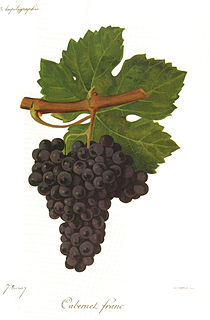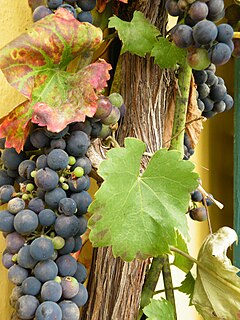
Cabernet Franc is one of the major black grape varieties worldwide. It is principally grown for blending with Cabernet Sauvignon and Merlot in the Bordeaux style, but can also be vinified alone, as in the Loire's Chinon. In addition to being used in blends and produced as a varietal in Canada and the United States, it is sometimes made into ice wine in those regions.

Aurore is a white complex hybrid grape variety produced by Albert Seibel and used for wine production mostly in the United States and Canada. Over a long lifetime Seibel produced many complex hybrid crosses of Vitis vinifera to American grapes. It is a cross of Seibel 788 and Seibel 29.

Alicante Bouschet or Alicante Henri Bouschet is a wine grape variety that has been widely cultivated since 1866. It is a cross of Petit Bouschet and Grenache. Alicante is a teinturier, a grape with red flesh. It is one of the few teinturier grapes that belong to the Vitis vinifera species. Its deep colour makes it useful for blending with light red wine. It was planted heavily during Prohibition in California for export to the East Coast. Its thick skin made it resistant to rot during the transportation process. The intense red color was also helpful for stretching the wine during prohibition, as it could be diluted without detracting from the appearance. At the turn of the 21st century, Alicante Bouschet was the 12th most planted red wine grape in France with sizable plantings in the Languedoc, Provence and Cognac regions. In 1958, Alicante Bouschet covered 24,168 hectares ; by 2011, plantings represented less than 4,000 hectares. This scenario is largely reversed in other regions of Europe, and in southern Portugal, where its wines are highly prized and frequently outscore traditional autochthonous varieties.

Carignan is a red grape variety of Spanish origin that is more commonly found in French wine but is widely planted throughout the western Mediterranean and around the globe. Along with Aramon, it was considered one of the main grapes responsible for France's wine lake and was a substantial producer in jug wine production in California's Central Valley but in recent years, it has been reborn as a flagship wine for many cellars in the south of France as well as Catalonia, Spain

Vidal blanc is a white hybrid grape variety produced from the Vitis vinifera variety Ugni blanc and another hybrid variety, Rayon d'Or. It is a very winter-hardy variety that manages to produce high sugar levels in cold climates with moderate to high acidity.

Hybrid grapes are grape varieties that are the product of a crossing of two or more Vitis species. This is in contrast to crossings between grape varieties of the same species, typically Vitis vinifera, the European grapevine. Hybrid grapes are also referred to as inter-specific crossings or "Modern Varieties." Due to their often excellent tolerance to powdery mildew, other fungal diseases, nematodes, and phylloxera, hybrid varieties have, to some extent, become a renewed focus for European breeding programs. The recently developed varieties, Rondo, and Regent are examples of newer hybrid grape varieties for European viticulturalists. Several North American breeding programs, such as those at Cornell and the University of Minnesota, focus exclusively on hybrid grapes, with active and successful programs, having created hundreds if not thousands of new varieties.

Regent is a dark-skinned inter-specific hybrid grape variety, used for making wine. It has both European and American vine species in its pedigree and a broad resistance against the most significant fungal diseases which affect grapes, such as downy mildew.
Adhémar F. de Chaunac was a French-born Canadian wine pioneer who helped lay the groundwork for a successful wine industry in Ontario and other eastern North American wine regions.

Aramon or Aramon noir is a variety of red wine grape grown primarily in Languedoc-Roussillon in southern France. Between the late 19th century and the 1960s, it was France's most grown grape variety, but plantings of Aramon have been in continuous decline since the mid-20th century. Aramon has also been grown in Algeria, Argentina and Chile but nowhere else did it ever reach the popularity it used to have in the south of France.

Solaris is a variety of grape used for white wine. It was created in 1975 at the grape breeding institute in Freiburg, Germany by Norbert Becker.

Quebec wine is Canadian wine made in the province of Quebec. The grape varieties grown in Quebec, both white and red, all have common qualities needed by the harshness of the winter season, including resistance to winter temperatures, resistance to spring freezes and being early ripening. Some 40 varieties are grown in Quebec, with the most commonly planted being Maréchal Foch, Frontenac, De Chaunac, Vidal and Seyval blanc.

Nova Scotia wine is Canadian wine produced in the Canadian province of Nova Scotia. Nova Scotia's wineries are primarily organized under the Wine Association of Nova Scotia, though not all wineries are members. The industry began in the late 1970s with the original Grand Pré Winery in the Annapolis Valley of Nova Scotia.

Goldriesling is a grape variety of the species Vitis vinifera used for white wine. It was created in 1893 by Christian Oberlin in Colmar, Alsace by crossing Riesling with another grape variety, which is sometimes given as Courtillier Musqué Précoce, but not identified conclusively.

Triomphe d'Alsace is a black grape variety of Franco-German origin, commonly grown in the United Kingdom.
Cascade is a red complex hybrid grape variety that was created by French viticulturist Albert Seibel in the early 20th century in Aubenas, Ardèche, in the Rhône Valley. It has been commercially available in North America since 1938 and has since been planted in Canada and the United States. However, in warmer climates the grape is highly susceptible to a number of grapevine viruses, which has discouraged plantings of the variety.
Marechal Joffre is a red inter-specific hybrid grape variety created by French viticulturist Eugène Kuhlmann (1858–1932). Like Marechal Foch, which was also created by Kuhlman, Marechal Joffre is named after a notable French World War I general, in this case Marshal Joseph Joffre.
Landot noir is a red hybrid grape variety that is a crossing of Landal and Villard blanc. Created after a series of trials between 1929-1949, the grape was introduced to Canada and the United States in the 1950s and today can be found in Quebec as well as New Hampshire where a varietal is produced by Jewell Towne Vineyards.

L'Acadie blanc is a white Canadian wine grape variety that is a hybrid crossing of Cascade and Seyve-Villard 14-287. The grape was created in 1953 by grape breeder Ollie A. Bradt in Niagara, Ontario at the Vineland Horticultural Research Station which is now the Vineland Research and Innovation Centre. Today the grape is widely planted in Nova Scotia with some plantings in Quebec and Ontario. Some wine writers, including those at Appellation America, consider L'Acadie blanc as "Nova Scotia’s equivalent to Chardonnay".



























